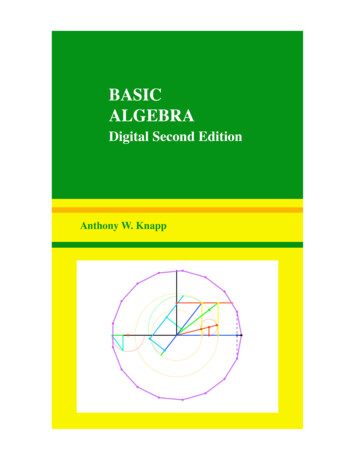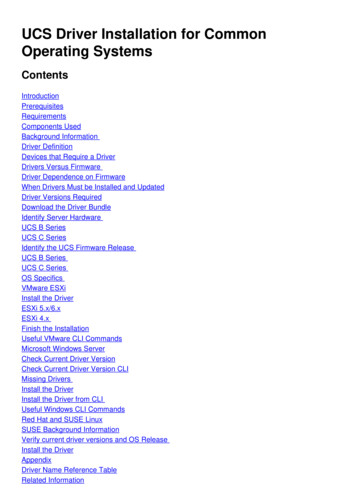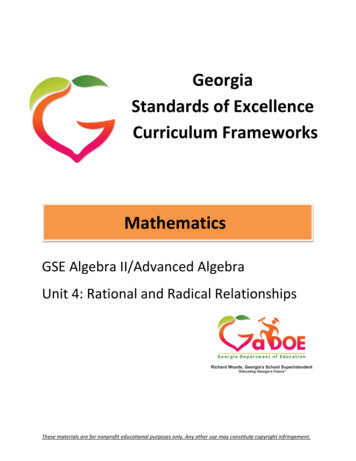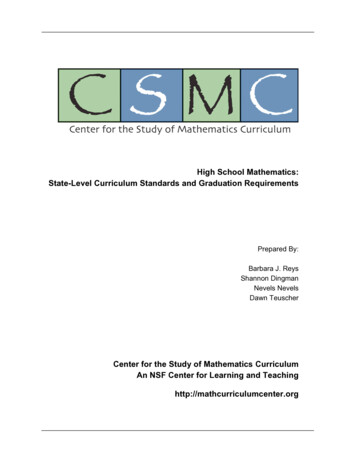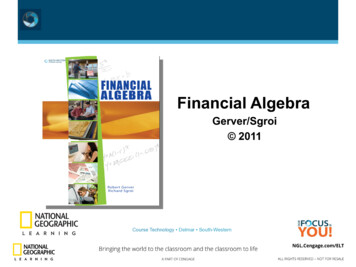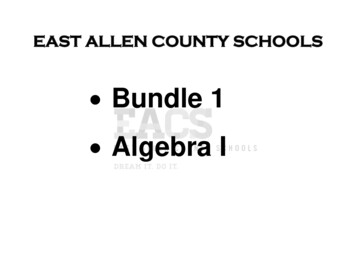
Transcription
EAST ALLEN COUNTY SCHOOLSBundle 1Algebra I
Number SenseBig Idea: Real OperationsEnduring UnderstandingsEssential QuestionsNumbers can be grouped into different sets.Every rational number can be written as a fraction.The sets of rational and irrational numbers, together, complete the Real NumberSet.The Order of Operations is a universal method used to simplify expressions.Performing a single operation with a rational and irrational number produces anirrational number.There is a unique relationship between squaring and finding the square root andcubing and finding the cube root.Estimation can be used to make a reasonable prediction of the outcome of acomputation.Positive integer exponents represent repeated multiplication.The Pythagorean Theorem can be used to identify lengths of sides for righttriangles.Indiana .3.48.4.58.5.1A1.1.1aWhat is the difference between rational and irrational numbers?What is the result of a computation that involves an irrational and a rationalnumber?Why is it necessary to have an Order of Operations to simplify numericalexpressions?How and when can estimation and mental math strategies be used?When is it appropriate to use Properties of Real Numbers?What is the relationship between squaring a number and finding the square rootof a number and the cubing and a number and finding the cube root or anumber?How could dimensional analysis by used in real-life situations?What is a real-life application of the Pythagorean Theorem?Core VocabularyA1.1.1bA1.1.3aA1.1.3bA1.1.5aCommon Q.1N.Q.3N.RN.3A.SSE.1A.SSE.1aBundle Performance TaskYou have been chosen to put the Pythagorean Theorem to use in real-life. You need to find at least 10 triangles in a real-life setting and use the PythagoreanTheorem to check to see if the triangles are right triangles. Students should then state whether the side lengths that they found of the triangle were Rational orIrrational while also giving an explanation. Students may need to convert the side lengths into one measurement. (Covert 5ft 2 in to 62 in). Students should try tobe as exact as possible using fractions or decimals if needed. Another option would be for the students to measure the diagonal of a rectangle along with the lengthand width to see if it has ninety degree angles (Students could measure a door or window opening). Students also need to research using the IPad careers that usethe Pythagorean Theorem. They should then write a report of their findings.ALGEBRA IMath Bundle 1Quarter 1Aug - Sept
Big Idea: Real OperationsNumber Sense
Real OperationsIndiana Learning TargetsAdd, subtract, multiply, and dividerational numbers (integers, fractions, andterminating decimals) in multi-stepproblems.Use estimation techniques to decidewhether answers to computations on acalculator are reasonable.-Prentice Hall Algebra 1 Lesson 1-2, 1-4, 1-5, and 1-6-Pearson iBook Algebra 1 Lesson 1.2, 1.5, and 1.6Operations with IntegersDry Erase ActivityBoard RacesQuizHomeworkWritten Explanation of EstimationQuizHomeworkUse mental arithmetic to compute withcommon fractions, decimals, powers,and percentages.Interpret positive integer powers asrepeated multiplication and negativeinteger powers as repeated division ormultiplication by the multiplicative-Prentice Hall Algebra 1 Lesson 1-2, 1-4, 1-5, and 1-6-Pearson iBook Algebra 1 Lesson 1.2, 1.5, and 1.6QuizHomework-Prentice Hall Algebra 1 Lesson 1-2-Pearson iBook Algebra 1 Lesson 1.3Written Explanation of DefinitionQuizHomework8.1.3Understand that computations with anirrational number and a rational number(other than zero) produce an irrationalnumber.Use the inverse relationship betweensquaring and finding the square root of aperfect square integer.Calculate and find approximations ofsquare roots.8.2.18.2.38.2.48.3.3Evidence of LearningWritten Explanation of DefinitionQuizHomeworkKnow that every rational number is eithera terminating or repeating decimal andthat every irrational number is anonrepeating decimal.8.1.7Resource of Ideas-Prentice Hall Algebra 1 Lesson 1-3-Pearson iBook Algebra 1 Lesson 1.3Rational Number OperationsIrrational NumbersNumber Set Definitions-Prentice Hall Algebra 1 Lesson 1-3, 1-4, 1-5, and 1-6-Pearson iBook Algebra 1 Lesson 1.5 and 1.6Rational Number OperationsUsing Rational Numbers-Prentice Hall Algebra 1 Lesson 10-3-Pearson iBook Algebra 1 Lesson 10.3Square Roots-Prentice Hall Algebra 1 Lesson 10-3-Pearson iBook Algebra 1 Lesson 10.3Square Roots8.1.28.1.6G8- Bundle 1-Prentice Hall Algebra 1 Lesson 1-2, 1-4, 1-5, and 1-6-Pearson iBook Algebra 1 Lesson 1.2, 1.5, and 1.6Written Explanation of DefinitionQuizHomeworkDry Erase ActivityQuizHomeworkDry Erase ActivityQuizHomework
Real OperationsG8- Bundle 1inverse.8.3.4Use the correct order of operations tofind the values of algebraic expressionsinvolving powers.-Prentice Hall Algebra 1 Lesson 1-2-Pearson iBook Algebra 1 Lesson 1.28.4.5-Prentice Hall Algebra 1 Lesson 11-2-Pearson iBook Algebra 1 Lesson 10.1-Prentice Hall Algebra 1 Lesson 4-1-Pearson iBook Algebra 1 Lesson 2.6QuizHomeworkA1.1.1aUse the Pythagorean Theorem and itsconverse to solve problems in two andthree dimensions.Convert common measurements forlength, area, volume, weight, capacity,and time to equivalent measurementswithin the same system.Evaluate real number expressions.Create a Problem and TradeDry Erase ActivityQuizHomeworkQuizHomeworkA1.1.1bOrder real number expressions.-Prentice Hall Algebra 1 Lesson 1-3-Pearson iBook Algebra 1 Lesson 1.1 and 1.2Operations with Integers-Prentice Hall Algebra 1 Lesson 1-3-Pearson iBook Algebra 1 Lesson 1.3A1.1.3aSimplify expressions by using theassociative and commutative propertiesto combine like terms.-Prentice Hall Algebra 1 Lesson 1-8-Pearson iBook Algebra 1 Lesson 1.4Algebraic PropertiesCreate a Problem and TradeQuizHomeworkDry Erase ActivityQuizHomeworkDry Erase ActivityQuizHomeworkA1.1.3bSimplify linear expressions by using thedistributive property.-Prentice Hall Algebra 1 Lesson 1-7-Pearson iBook Algebra 1 Lesson 1.7Algebraic PropertiesDry Erase ActivityQuizHomeworkA1.1.5aUse dimensional unit analysis toorganize conversions and computations.-Prentice Hall Algebra 1 Lesson 4-1-Pearson iBook Algebra 1 Lesson 2.6Dry Erase ActivityQuizHomework8.5.1Correlating CC/Learning TargetsTeacher Notes
Real OperationsG8- Bundle 1
Prentice Hall Algebra 1 Lesson 10 3-Pearson iBook Algebra 1 Lesson 10.3 Square Roots Dry Erase Activity Quiz Homework 8.1.7 -Calculate and find approximations of square roots. - Prentice Hall Algebra 1 Lesson 10 3 Pearson iBook Algebra 1 Lesson 10.3 Square Roots Dry Erase Activity Quiz Homework 8.

